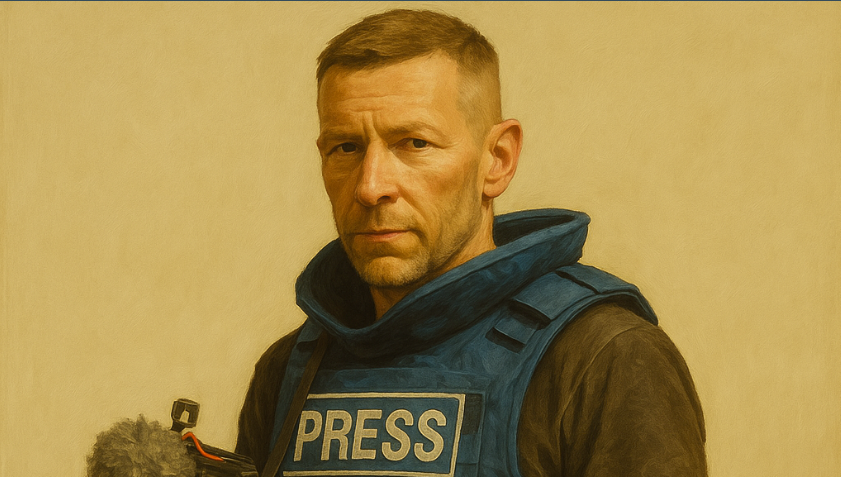
On 6 March 2022, a Russian artillery strike hit a civilian evacuation route near the Irpin bridge outside Kyiv. Among the victims was the Perebyinis family—a mother, her two children, and a man who was helping them flee. Their deaths were captured by Andriy Dubchak of Frontliner, and New York Times photographer Lynsey Addario.
“This footage clearly showed that Russia was killing civilians,” says Dubchak. “It went viral across global media and talk shows for weeks, before Ukraine’s liberation of Irpin and Bucha revealed even more atrocities.”
Dubchak is the founder and editor-in-chief of Frontliner, a digital media outlet launched in the spring of 2021 to document Russia’s war in eastern Ukraine.
Created just months before the full-scale war thanks to a crowdfunding campaign and a matching grant, it has since become one of the country’s leading war-reporting platforms. It is the recipient of several awards, including the top prize at 2025 Ukraine’s Honour of the Profession journalism competition.
The concept behind Frontliner came long before the 2022 full-scale invasion. Dubchak wanted a newsroom with experienced personnel, proper gear, satellite connectivity and vehicles—resources few Ukrainian outlets possessed. He wanted to tell in-depth stories from the frontlines, at a time when public interest had waned.
Only a handful of Ukrainian outlets were covering the war in the East, and these were mainly brief and repetitive reports. Dubchak wanted to do better.
“In 2021, there was a major escalation on the front,” Dubchak says, “We travelled from Mariupol to Luhansk thinking we’d be the tenth crew there, but we were the first. That’s when I realised something had to be done.”
“We worked all through the spring, the summer, and autumn,” he recalls. “When reports of a likely escalation emerged—what we now call the full-scale war—interest in rose sharply.”
Back then, Frontliner was a three-person team: Dubchak, journalist Olena Maksymenko, and photographer Yeva Fomycheva. While others evacuated their families, Dubchak remained in eastern Ukraine, beginning in Sievierodonetsk and then heading back to Kyiv.
“There was a question: should I go to Kharkiv or Mariupol?” he says, “Both were under attack. But when we got information that Russian troops were moving toward Kyiv, I changed direction.”
That decision put him at the nearby Irpin bridge just days later, where he filmed the footage of the Perebyinis family. Dubchak was also among the first to document Russian atrocities uncovered across northern Ukraine in April 2022.
Today, Frontliner's newsroom covers military operations, displacement, and the war’s long-term social effects. The now 15-person team cover all aspects of life in the territories directly impacted by the ongoing war, often from challenging and remote locations. They talk with locals, sourcing information first-hand and revealing previously unreported stories.
Operating across Ukraine, they dispatch in pairs to frontline areas, often with military escorts. In a recent assignment, the team embedded near Pokrovsk, a city under heavy Russian attacks.
The media's audience are residents of Donetsk, Luhansk, Kherson, Zaporizhzhia, and other regions near the front line, as well as Ukrainians in other regions and international audiences. They also translate stories into English.
“Ukrainians live this reality,” Dubchak says, “Whether they want to or not, they’re aware. But many others have no idea what was happening in Ukraine before 2022."
Frontliner’s stories have been picked up by Reuters, AP, Getty, CNN, and BBC. Their reporting often sparks wider media coverage.
"One story that went viral was about the "Witches of Bucha"—a mobile air defence unit made up almost entirely of women. Now they have a year-long waiting list of volunteers who want to join them,” Dubchak says. “Their commander joked that I’d ruined it for them with all that popularity.”
While syndicated articles raise funds and boost reach, financial stability remains a major concern.
“It's hard to become sustainable,” says Dubchak. “Reporting is expensive—vehicles, safety gear, experienced people all cost money. Few media can afford to do the kind of reporting we do. But we believe our reports are important and that they have longevity. In years to come, people will still know what was happening here.”
EED provided Frontliner with a grant to improve their institutional capacity and help their financial stability.
Dubchak admits that the physical risks of frontline reporting have increased dramatically. The team undergoes regular safety and medical training.
“Drones now reach 20 km from the front. Even further away, there’s a constant risk from the sky,” he says.
There’s also narrative fatigue.
“People are tired of photos of rubble and bodies,” he says. “We have to find new ways to tell the story without distorting the truth.”
“Our goal is to keep raising quality,” Dubchak says. “That means more training, more translations, and deeper work with international audiences. Frontliner isn’t just a media project. This is work that must be done, even when it’s hard. We are where we’re needed. And if we don’t tell the story, who will?”
This article reflects the views of the grantees featured and does not necessarily represent the official opinion of the EED.
This initiative was supported thanks to the contribution of the Government of Canada to EED.